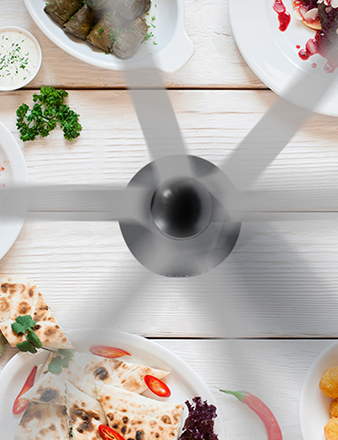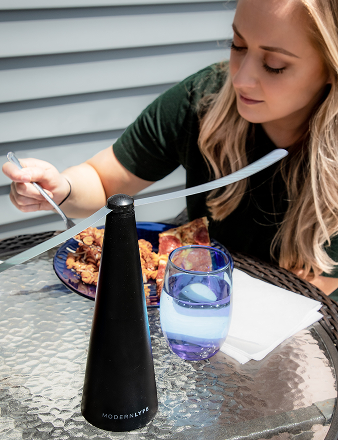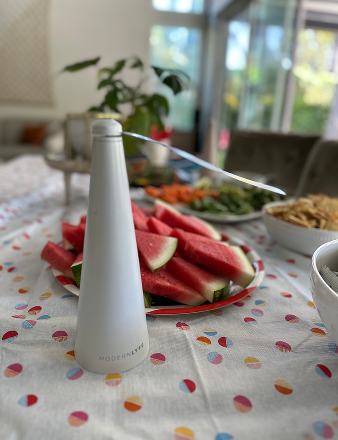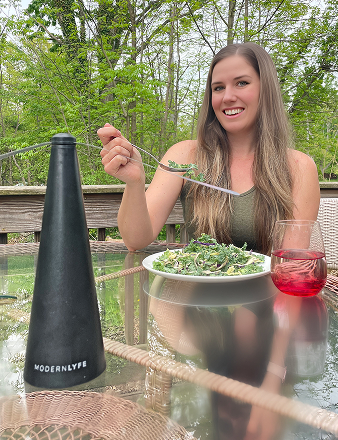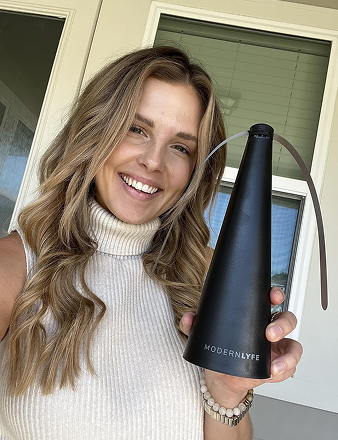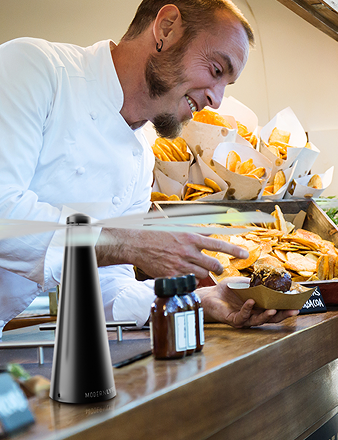A constant swarm of flies is more than an annoyance—it's a battle for your space. The best weapon is a fly trap with bait, a device that uses a powerful attractant to lure flies in and stop them for good. But success isn't just about hanging a trap; it's about understanding how to make it work for you.
Win the War on Flies
Forget chasing flies with a swatter. A baited fly trap is a smarter, more effective way to reclaim your home, patio, or business. This method doesn't just catch random flies; it actively draws them away from your living areas by targeting their powerful sense of smell. Once you understand how these traps work, you can turn a simple device into a highly effective fly control system.
This guide provides a clear roadmap. We'll cover:
- The science behind what makes bait irresistible to flies.
- How to choose the right bait for your specific fly problem.
- Where to place traps for maximum impact.
- Simple maintenance tips to keep them working all season.
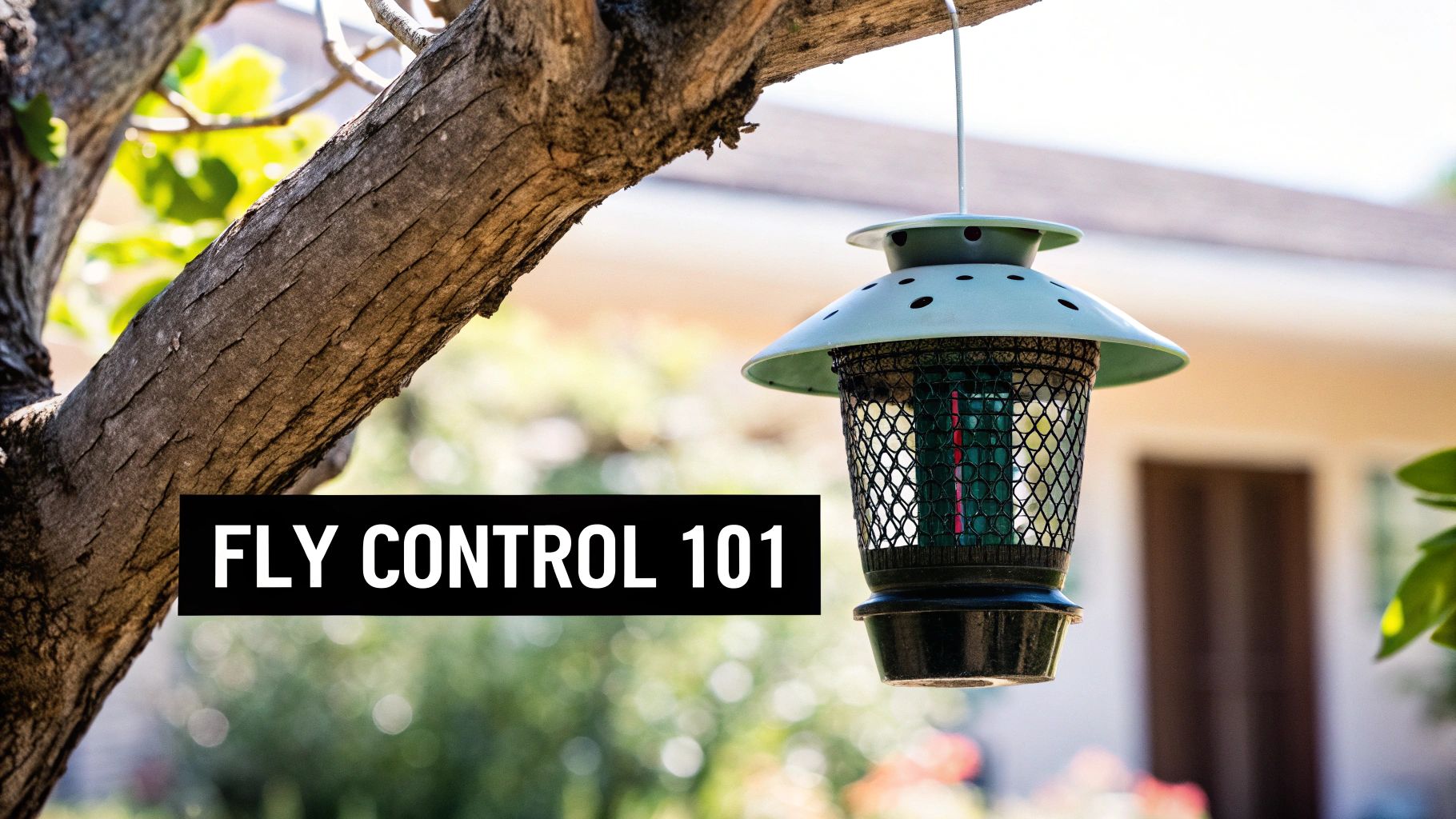
Why Baited Traps Are the Go-To Solution
These traps are popular for one reason: they work. The global market for fly traps, a large portion of which are baited models, was valued at USD 1.2 billion in 2024 and is projected to reach USD 2.5 billion by 2033. This growth is driven by a greater awareness of the hygiene issues flies cause, as they are known carriers of disease. You can find more details on the fly trap market growth on Verified Market Reports.
A baited fly trap acts like a venus flytrap for your property. It uses an irresistible scent—the promise of an easy meal—to lure its target into an inescapable container.
This guide delivers practical, actionable strategies for real results, helping you create a more comfortable and hygienic environment.
How a Fly Trap with Bait Works
A baited fly trap is simple and effective. It works by hacking a fly’s most powerful instinct: its sense of smell. Think of it as a potent, scented beacon that only flies can detect.
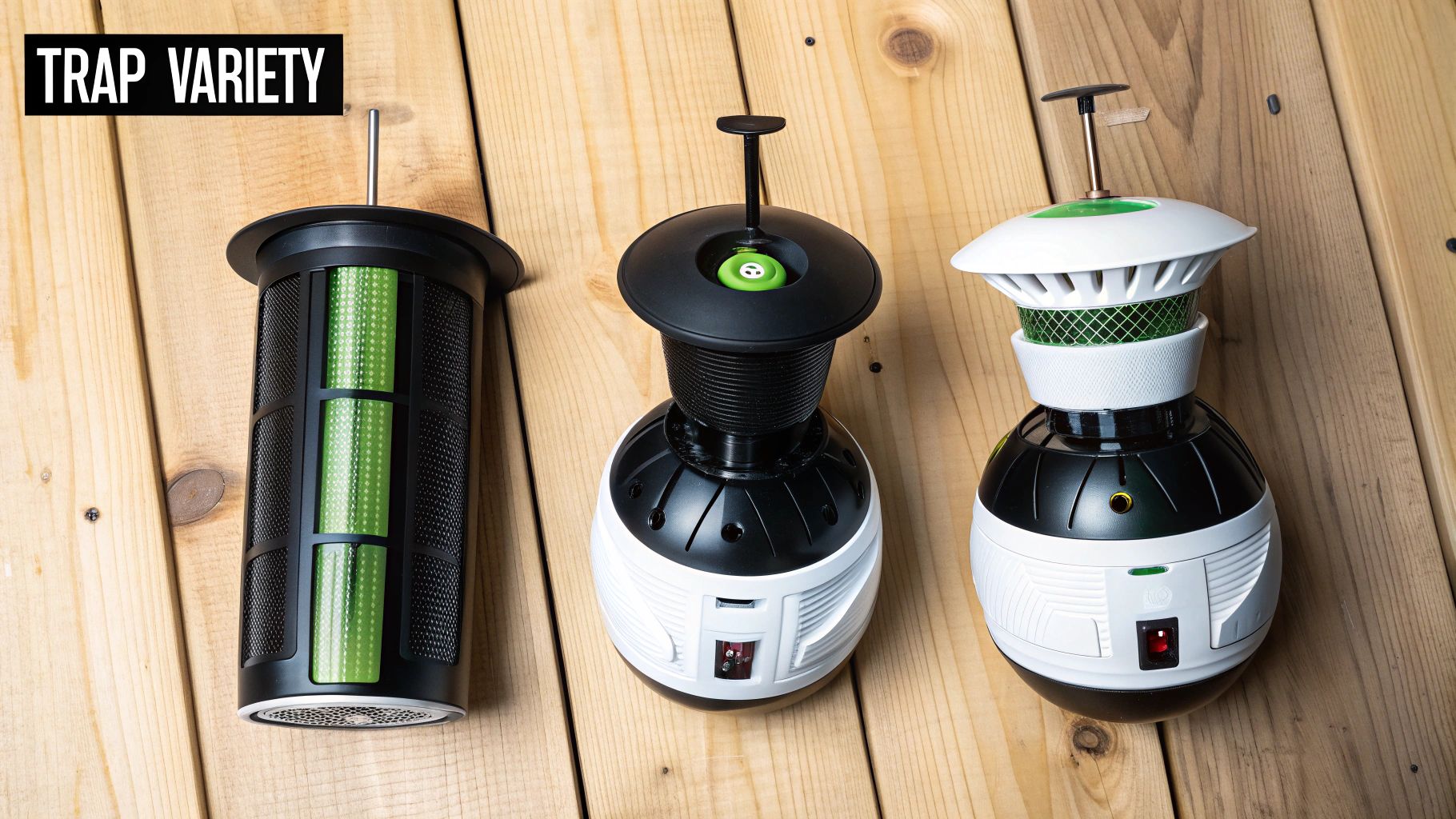
The system relies on a two-part process: attraction and containment. First, the bait draws flies in from the surrounding area. Then, the trap’s design ensures they cannot leave. This combination is why it works so much better than passive methods like sticky strips.
The Power of the Attractant
The core of a baited fly trap is the bait itself. Flies are hardwired to seek out the smells of decay and fermentation, as these scents signal food and a place to lay eggs. The bait is engineered to mimic these irresistible smells using powerful, non-toxic ingredients.
Once you add water to the bait powder, it releases a strong aroma. While unpleasant to humans, it’s an unavoidable dinner bell for flies. They can detect these scents from a distance and are biologically compelled to investigate.
The concept is simple: create a smell so tempting that flies abandon everything to follow it. The trap becomes the most interesting thing in the yard, pulling flies away from your gathering and toward their final destination.
This powerful lure is the most critical component. Without effective bait, a trap is just an empty container. For flies in the kitchen, understanding the principles of a food fly trap can offer more insight into the scents they can't resist.
The Ingenuity of Trap Design
After the bait lures the fly in, the trap's physical design takes over. Traps come in various forms, from disposable bags to reusable jars, but most share a clever one-way entry system. The goal is to ensure that once a fly gets in, it stays in.
This is typically achieved with a cone or funnel-shaped entrance.
- Easy Entry: The funnel is wide at the top, creating an obvious path for a fly to crawl inside as it follows the scent.
- Difficult Exit: Once inside, the fly becomes disoriented. The small, narrow opening of the funnel is hard to find from within, making escape nearly impossible.
The fly is now trapped. It will fly around until it tires and falls into the liquid bait below. This efficient system uses the fly’s own instincts against it. The two-step process of lure-and-capture makes a fly trap with bait a reliable pest control tool.
Choosing the Right Bait for Maximum Attraction
Selecting the right bait is the most critical step in setting up a fly trap. The right choice turns your trap into a fly-catching machine; the wrong one renders it useless. Not all baits are created equal, as different fly species are attracted to different smells.
Think of it like fishing: you wouldn't use the same lure for a small fish as you would for a large one. The same principle applies to your fly trap with bait. You must match the attractant to the specific pest you're targeting.
Commercial Baits vs. DIY Recipes
Commercial baits are typically sold as powerful, water-soluble powders. They are scientifically formulated with food and scent attractants that common flies find irresistible. These baits are convenient and highly effective, especially for house flies and blowflies drawn to protein or intensely sweet smells.
Alternatively, you can create your own bait at home. A simple mix of sugar and water will attract some flies, while apple cider vinegar works well for fruit flies. For larger, more resilient species, you can use potent options like old meat scraps or fish bits. These are incredibly effective but produce a powerful, unpleasant odor.
To learn more about different bait options, explore our comprehensive guide on fly trap liquid.
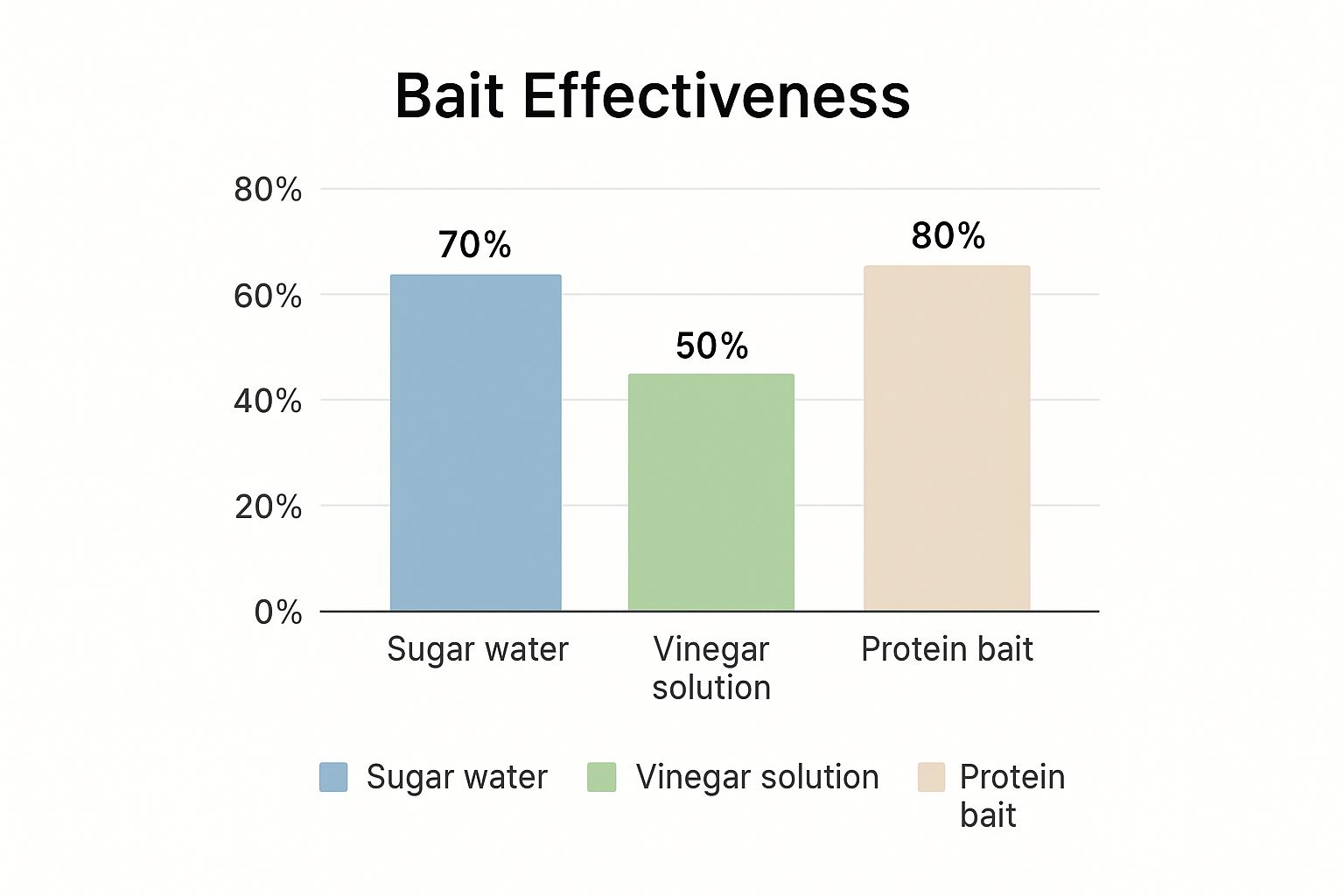
As shown, protein-based baits consistently achieve the highest attraction rates for the most common nuisance flies, outperforming simpler sugar or vinegar solutions.
Matching Bait to Your Fly Problem
First, identify what kind of fly you’re dealing with. Are tiny gnats swarming your fruit bowl, or are large, buzzing flies making your patio unusable? Each problem requires a different solution.
The fly trap industry is evolving, with a growing demand for smarter, eco-friendly devices. The market was valued at USD 404 million in 2024 and is expected to reach nearly USD 562 million by 2030. This growth highlights consumer demand for effective solutions that don't rely on harsh chemicals, placing more importance on well-formulated bait.
The right bait doesn't just attract flies; it selectively targets the exact species causing the problem. A potent protein bait is overkill for fruit flies, and a vinegar trap won't affect a blowfly infestation.
This quick-reference table makes it easy to see which baits work best for common flies, helping you choose the perfect attractant for your situation.
Bait Effectiveness for Common Fly Species
| Bait Type | Primary Target Flies | Pros | Cons | Ideal Location |
|---|---|---|---|---|
| Commercial Powder | House Flies, Blowflies | Highly effective, long-lasting, easy to use. | Can have a very strong, unpleasant odor. | Outdoors, far from living areas and windows. |
| Sugar Water/Fruit | House Flies, Fruit Flies | Simple to make, low odor, uses household items. | Less potent, may attract other insects like ants. | Patios (with caution) or near compost bins. |
| Vinegar Solution | Fruit Flies | Excellent for targeting fruit flies specifically. | Not effective for larger fly species. | Indoors near kitchens or fruit bowls. |
| Protein (Meat/Fish) | Blowflies, Flesh Flies | Extremely powerful attractant for large flies. | Overpowering and foul odor, very messy. | Far perimeter of a property, near dumpsters. |
As the table shows, there is a trade-off between effectiveness, convenience, and odor. Matching the bait to both the fly and the location is the secret to success.
Strategic Trap Placement for Best Results
Where you place your fly trap is as important as what you put inside it. A perfectly baited trap in the wrong spot won't catch much. A well-placed trap, however, can make a significant difference.
The main goal is simple: intercept flies before they get near your house or patio.
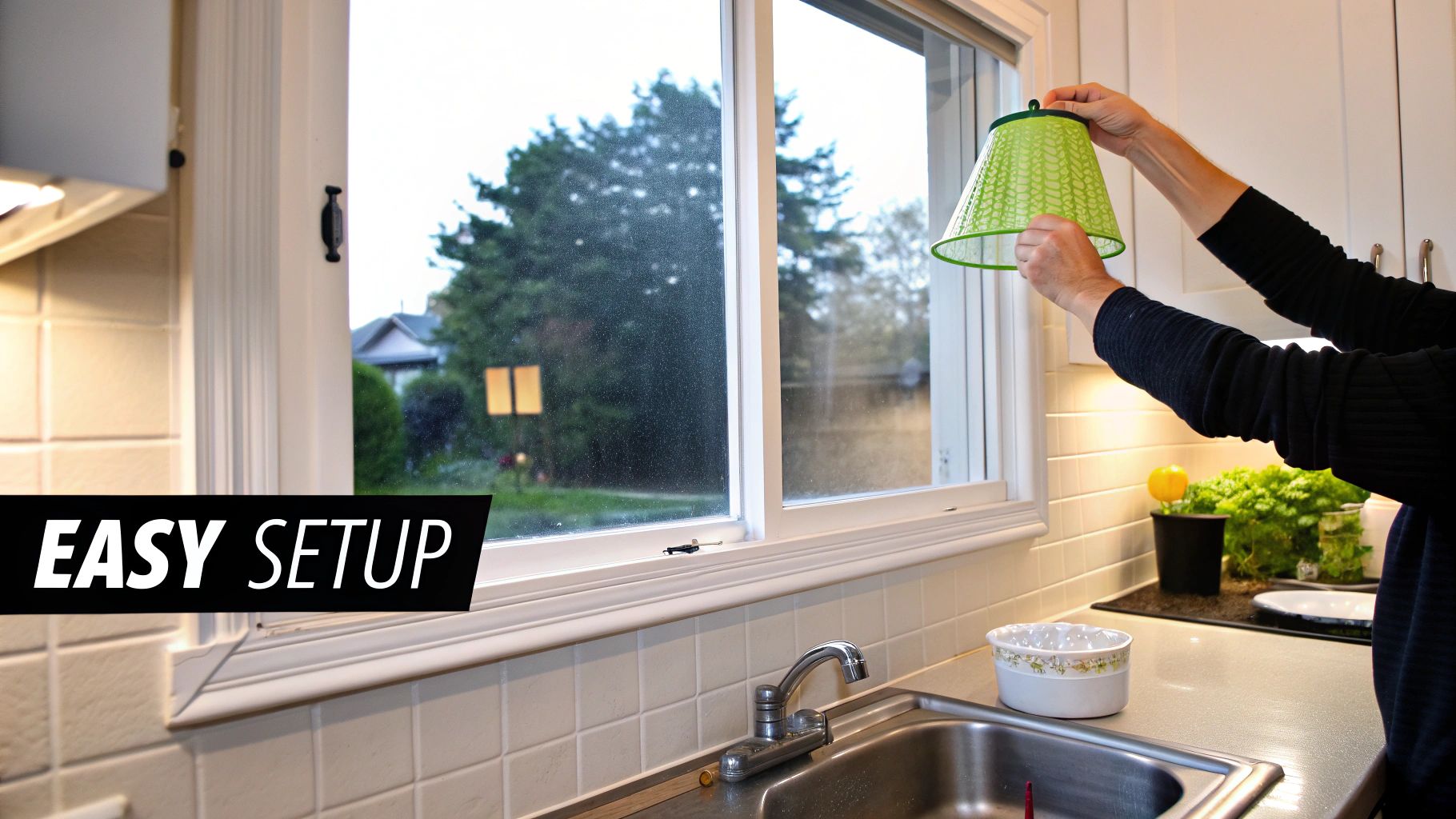
To do this effectively, you need to think like a fly. Identify their sources and breeding grounds, such as garbage cans, compost heaps, or pet areas. These are the fly hotspots, and they are the ideal locations for your trap.
Here is the number one rule: place the trap away from the areas you use. Hanging a smelly trap next to your patio table is counterproductive. You will end up inviting the entire local fly population to your outdoor gathering.
The Golden Rule of Distance
Your trap is a diversion, not a centerpiece. The goal is to pull flies away from your living space. For most yards, a distance of 20-30 feet away from doors, windows, and outdoor seating areas is ideal.
This creates a scent perimeter that intercepts flies while they are still far from you. The trap's powerful odor works to your advantage, keeping your deck or patio a fly-free zone.
Think of it as creating an irresistible detour. You are guiding flies away from your personal space and directly into a trap they cannot escape.
For larger properties, such as farms or commercial spaces, you will need to extend this perimeter even further. The principle remains the same: identify where people gather and set your traps well beyond that area.
Using the Environment to Your Advantage
Distance is key, but you can also use your surroundings to enhance your trap's effectiveness. Sunlight, for example, is crucial for bait activation.
Hanging your trap in a sunny spot warms the bait solution. This warmth accelerates the fermentation process, making the scent stronger and helping it travel further on the breeze. It's a simple trick that yields a big impact.
Keep these environmental factors in mind for optimal placement:
- Sunlight: Always choose a sunny location to maximize the bait's scent output.
- Wind Direction: Note the prevailing wind direction. Place traps downwind from fly sources (like a dumpster) and upwind from your home.
- Height: Hang traps about 4-5 feet off the ground. This aligns with the typical flight path of most common flies.
This type of strategic thinking is essential in commercial settings. In 2023, the global fly trap market reached a volume of 16.9 million units. The commercial segment was valued at around USD 300 million, driven by restaurants and hotels dealing with heavy fly pressure. You can explore more details about the commercial fly trap market for more information.
By mastering placement, you can turn a basic trap into a highly effective pest control tool.
Setup and Maintenance for Optimal Performance
A baited fly trap requires some attention to perform at its best all season. Proper setup and maintenance are the difference between a trap that works okay and one that is a fly-catching machine.
First, activate the bait. Most commercial baits are dry powders that require water. A key tip is to always use warm water, as it dissolves the powder more effectively and activates the scent attractants faster. Simply add the powder to the trap and fill it to the designated line.
Assembly and Proper Hanging
Once the bait is mixed, assembling the trap is usually straightforward. Follow the instructions to secure the top lid or funnel. This component is crucial, as it creates the one-way entrance that allows flies in but prevents their escape.
The ideal hanging height is four to five feet off the ground, which corresponds with the typical flight path of most flies. Find a sturdy branch or hook where the trap won't be disturbed by wind or pets.
Proper setup gives your trap a head start. When you mix the bait correctly and hang it in the perfect spot, you create an irresistible invitation for every fly in the area.
How to Maintain Your Trap for Long-Term Success
Over time, you'll notice your trap catching fewer flies. This is normal. The trap may be full, the water may have evaporated, or the bait may have lost its potency. Regular checks are necessary.
Follow this simple maintenance checklist:
- Top Off the Water: On hot days, evaporation can dry out the bait. Check the trap every few days and add more water to keep the solution active.
- Monitor the Fill Level: A full trap can't catch more flies. Once it's about two-thirds full, it's time to empty or replace it.
- Replace Bait on a Schedule: Most bait formulas last 2 to 4 weeks. Set a reminder to replace it with a fresh batch to maintain effectiveness.
Disposing of the contents is simple. For disposable bag traps, seal them and place them in the outdoor trash. For reusable jugs, empty the contents, rinse the trap with warm, soapy water, and refill with fresh bait.
This simple routine ensures your fly trap with bait remains a reliable tool in your fight against flies.
Common Fly Trap Mistakes to Avoid
Even the best fly trap with bait is only as good as its setup. If you aren't seeing the desired results, it's likely due to a few common, fixable mistakes. Let's review these pitfalls so you can get it right from the start.
The single biggest mistake is placing the trap too close to your house. It seems intuitive to put the trap where the flies are, but this approach will backfire. The bait is designed to be powerful and draw flies from a distance. Placing it near your outdoor seating is like sending an invitation for every fly in the vicinity to join you.
Another common error is a bait mismatch. A heavy-duty, protein-based bait for outdoor flies will not work on the small fruit flies in your kitchen. You must match the bait to the specific fly you are targeting.
Forgetting Basic Maintenance
Once your trap is in place, you can't just set it and forget it. A common oversight is letting the bait dry out, which stops the fly-catching process entirely.
A dry trap is a useless trap. The bait needs water to activate its scent. Once the liquid evaporates, the trap goes silent and no longer broadcasts its signal to nearby flies.
Here are a few other missteps that can reduce your success:
- Hanging at the wrong height: Most common nuisance flies fly about four to five feet off the ground. If your trap is too low or too high, it's out of their flight path and less likely to be found.
- Placing it in the shade: Sunlight warms the bait, which strengthens the scent and increases its range. A trap in a cool, shady spot will not perform at its full potential.
- Leaving a full trap for too long: A full trap has completed its job. If left for weeks, it can become a breeding ground itself, creating a new problem.
Avoiding these simple mistakes will make a significant difference. Your trap will function as intended, efficiently luring flies away from your home so you can enjoy your outdoor space in peace.
Answering Your Fly Trap Questions
Even with a solid plan, you may have questions when using a fly trap with bait. Here are answers to some of the most common inquiries.
How Long Does Fly Bait Last?
Most commercial baits remain effective for two to four weeks. However, this timeline can vary with the weather. Hot, dry conditions can cause water to evaporate, weakening the bait's scent.
Check your trap weekly. If the liquid level is low, add some water to reactivate the attractant.
As a general rule, plan to replace the bait or the entire trap every 30 days. You should also replace it sooner if it becomes about two-thirds full of flies.
Are These Traps Safe for People and Pets?
The strong, unpleasant odor of the bait is a common concern. While it smells bad to us, the ingredients are generally non-toxic and not chemically harmful to people or pets. The powerful stench is precisely what makes the trap so effective at attracting flies.
The key is smart placement. Follow the placement rules discussed earlier: hang the trap far from your living spaces and high enough to be out of reach of children and pets.
Can I Use an Outdoor Trap Indoors?
The answer is a firm no. It is a bad idea to bring an outdoor baited fly trap inside. These traps are designed to broadcast a potent smell over a large area, which would be overwhelming in an enclosed space.
Worse, you would end up luring flies from outside into your house, creating a bigger problem. For indoor fly control, a different tool is needed. If you are dealing with smaller pests, our guide on choosing an effective fruit fly catcher can help you find the right solution.
Ready to create a more comfortable, fly-free environment for your home or business? The innovative fly fans from MODERN LYFE offer a stylish and effective solution to keep pests away from your food and guests. Explore the collection and find your perfect match at modernlyfe.com.

